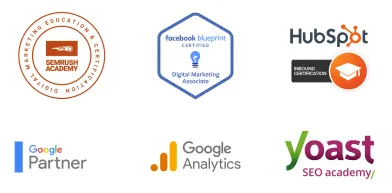TO LEARN IS TO GROW
Learning Center
We do our research and publish our results. Should probably call this the Growing Center.


How Do I Create Email Retargeting Campaigns (to Increase My E-Commerce Sales)?
Effective email retargeting campaigns can increase your e-commerce sales and customer retention rates. Here’s how you can put together your very own retargeting campaign for your online store.
Historically and statistically, brands find more success in retargeting clients, especially in sales generation, than acquiring new customers. Retargeting campaigns provide better results because you deal with people who already have experience with your products and services.
According to a Google report involving a US hotel chain that used remarketing, the company grew its revenue by around 60% and its bookings by 57%, generating $60,000 for just an $800 budget.
A separate study also showed that retargeting campaigns produced a 152% higher engagement rate than acquiring new customers.
To help you get started with email remarketing campaigns, we compiled some foolproof ways to coax your target audience from buying your products or signing up for your paid services.
Remind them through wishlist sales and discounts
For e-commerce, a wishlist is a goldmine of opportunities because it alerts customers about a sale; plus, people use it to save items for future flash sale occasions. In addition, some companies have also found success–i.e., higher revenue–after giving a discount on some of the products on the wishlist.
A wishlist can also help you learn your customers’ preferences and online behavior and know what products you should stock up on, especially during the holidays.
Retarget shoppers by mentioning their abandoned shopping cart
Customers who have abandoned their shopping cart are generally viewed as low-hanging fruits–they just need a little push and encouragement to complete their purchase. Just make sure that you make a killer subject line to increase the open rate of your email remarketing campaign.
These are some of the tips to create email remarketing campaigns for abandoned shopping carts:
Show the products using professional-looking, fast-loading photos.
Create a sense of urgency like limited-time offers and discounts.
Include a clear call-to-action message.
Remind the shoppers of what they have left behind.
Send multiple remarketing emails to increase your conversion rate.

Suggest another product
This email marketing campaign is for people who have already made a purchase. Because you already have data about their preference, it becomes easier to find out what other items might appeal to them.
For example, if a customer recently bought a paint kit, your follow-up email could mention paper pads, artist’s boards, and other similar products. Make sure that you only suggest products that reflect your clients’ online buying behavior, as failure to do so can lead to loss of trust, or worse, prompt them to unsubscribe from your email list.
Learn your customers' buying behavior
This is almost similar to the “suggest related products” follow-up email, although it focuses more on their buying pattern. So, for example, if you have customers that often buy party platters during Thanksgiving, why not send them an email a week or a few days before Christmas, New Year’s Eve, and other special occasions to remind them that it’s more convenient to purchase food trays than to cook meals for a crowd.
Share tips and tricks with your clients
If you want your customers to view you as an industry leader, make sure that you provide how-to blogs, video tutorials, and cheat sheets. For example, an e-commerce business that sells swimwear can create an infographic to help women choose the most flattering cut for their body shape, height, and frame.
When sending email newsletters, make sure you follow these guidelines:
The subject line should reflect the customers’ pain points.
Keep the text short and direct.
If you’re going to use photos and other visual elements, make sure they are web-friendly–i.e., fast-loading and mobile-friendly.
Include a link if you want to give your customers more in-depth tips.
Avoid attachments because they are often seen as red flags by spam filters.
Include a call-to-action message to drive traffic to your website or webpage of the relevant product.
Invite the recipients to share their ideas and recommendations.
Remind them about their “last chance to purchase”
One effective way to persuade people to buy your product is to give them a sense of urgency. For instance, tell them about your items that are almost out of stock or will no longer be produced by the manufacturers. This email remarketing campaign can also mention the end-of-season or end-of-year sales.
Share your new products
If you have new products or just a new shipment, you must mention this to your customers by sending them a follow-up email. This technique not only drives traffic to your website but also reinforces brand loyalty and recall.
Make sure that your “new product” promotions should not include more than seven items (more than this number and you risk overwhelming your customers) and use catchy photos and product links to encourage them to visit your website.

Did you enjoy the blog? If yes, you may also want to read our post, “The Benefits of Email Marketing for Small Businesses.“
At LOJO Marketing, we help small- and medium-sized businesses increase their revenue and customer retention rates through email marketing, SEO, social media, PPC, and other inbound marketing tools. For more information, you can schedule a free consultation with Stephen or call us at (916) 303-4080.
Built for Growth. Backed by 25 Years of Trust.
For over two decades, LOJO has been a trusted partner to hundreds of businesses just like yours. Whether working directly with owners, managers, teams, or boards of directors, our goal remains the same: to be a reliable and results-driven asset to your business.
Over the years, we’ve carefully built a team of experts—each selected for their unique skills, strengths, and personalities. Our clients choose LOJO because they know we genuinely care about their success.
And after 25 years of helping businesses grow, we’re more committed than ever.



Built for Growth. Backed by 25 Years of Trust.
For over two decades, LOJO has been a trusted partner to hundreds of businesses just like yours. Whether working directly with owners, managers, teams, or boards of directors, our goal remains the same: to be a reliable and results-driven asset to your business.
Over the years, we’ve carefully built a team of experts—each selected for their unique skills, strengths, and personalities. Our clients choose LOJO because they know we genuinely care about their success.
And after 25 years of helping businesses grow, we’re more committed than ever.




Matthew Rogers, President
iProspect Check
After spending several months reviewing multiple proposals from several different companies we engaged LOJO to develop a new website that represents our company effectively. We worked initially with Stephen Platte who helped create the scope of the project. Stephen was knowledgeable and always followed up with me on time and as promised.
He "closed the deal" for LOJO with his professionalism, service orientation and easy going approach. Once we signed the contract we were introduced to Jay Kelly who would be the creative lead for LOJO. This was the most challenging part of the project for my company, as there was no shortage of ideas from our side. Jay managed the project flawlessly, and once we had all agreed to the design, Jay introduced us to Eric.
Eric Lay is one of the founders of LOJO. Eric took the design we had developed and brought it to life. We delivered content as quickly as he requested it. Eric kept the project on task and we responded by exceeding every deadline for content. In turn, once provided, literally not a day went by that Eric didn't add the content and take the next step. In just a few weeks we launched our new website. Eric is a pleasure to work with.
His positive attitude and consultative approach really enhanced the experience and made a big difference for us in the outcome of our project. We would welcome you to visit our website to take a look at the quality work of LOJO. We are very pleased with LOJO and look forward to working with them in the future as we pursue an aggressive SEO strategy."
After spending several months reviewing multiple proposals from several different companies we engaged LOJO to develop a new website that represents our company effectively. We worked initially with Stephen Platte who helped create the scope of the project. Stephen was knowledgeable and always followed up with me on time and as promised.
He "closed the deal" for LOJO with his professionalism, service orientation and easy going approach. Once we signed the contract we were introduced to Jay Kelly who would be the creative lead for LOJO. This was the most challenging part of the project for my company, as there was no shortage of ideas from our side. Jay managed the project flawlessly, and once we had all agreed to the design, Jay introduced us to Eric.
Eric Lay is one of the founders of LOJO. Eric took the design we had developed and brought it to life. We delivered content as quickly as he requested it. Eric kept the project on task and we responded by exceeding every deadline for content. In turn, once provided, literally not a day went by that Eric didn't add the content and take the next step. In just a few weeks we launched our new website. Eric is a pleasure to work with.
His positive attitude and consultative approach really enhanced the experience and made a big difference for us in the outcome of our project. We would welcome you to visit our website to take a look at the quality work of LOJO. We are very pleased with LOJO and look forward to working with them in the future as we pursue an aggressive SEO strategy."

Matthew Rogers, President
iProspect Check
The team at LOJO were wonderful to work with. They are well organized and very patient as we worked through our marketing strategy and developed a well thought out and clear action plan at a reasonable price. We will definitely be back for our future campaign needs."

Jon Crosby, Founder
Dazil

